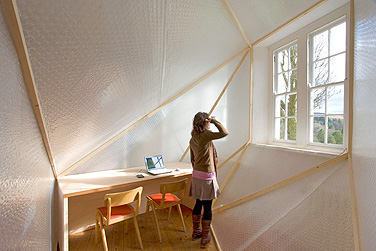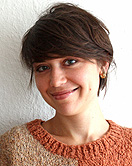News
Architects exhibit in Barcelona

“Selective Insulation” project in which Stephanie Davidson and Georg Rafacilidis culled warm, bright usable space from large uninsulated rooms in an art school in Hexham, England. Exhibited at eme3, Barcelona, July 1 to 3, 2011.
Two UB architects presented a unique solution to the uncomfortably chilly temperatures of an old stone building in England as part of the sixth annual International Architecture Festival eme3_2011, held July 1-3 in Barcelona.
Georg Rafailidis, assistant professor, and Stephanie Davidson, clinical assistant professor, both in the School of Architecture and Planning, were among a select group of professionals invited to participate in the festival, presenting “Selective Insulation,” a project in which they culled intimate and comfortable microclimates from the vast, cold rooms of a 162-year-old building in Hexham, England.
The Hexham building is a masonry structure that now serves as an artists’ facility. It is not insulated, and ordinarily would require intensive heating much of the year to maintain temperatures warm enough for its occupants.
A conventional approach to improving its thermal efficiency would have been to line the inside of the stone walls with a new layer of insulation, a measure that would result in a loss of all thermal mass in the stone but would create an equally distributed warm zone inside the building.
Davidson and Rafailidis, however, called for a more strategic approach to the problem. Rather than insulate and heat either the whole building or its individual rooms, the architects used selective insulation to define small areas in the structure that can be warmed easily during the cold months of the year and used as studio spaces.
They employed simple wooden frames covered with two-ply bubble wrap(normally used to insulate greenhouses) to construct small, naturally lit and attractive sealed pockets of warmth within which artists can work.
The size and shape of the spaces are determined by the area needed for a particular work activity. One space, for instance, is defined by a desk for two people, a door and a window. The wooden frame and bubble wrap enclose an insulated working space for two people that is ample and pleasant.
The eme3 festival, a market for avant-garde architecture, was founded in 1999 by the cultural association adn. This year, the festival addressed, among other topics, the contradictions between sustainable development and “greenwashing,” the deceptive use of pro-green public relations or green marketing to promote a misleading perception that a company’s policies or products are environmentally friendly.
“These two faculty members are making a significant and artful contribution to the global discussion on sustainability, and make an important contribution to our faculty depth in this subject,” says Robert Shibley, dean of the School of Architecture and Planning. “Their participation in this festival recognizes the international interest their work is generating.”
Shibley points out that the festival is one that emphasizes architectural innovation marked by sustainability, space research, urban integration and the structure and technology of materials. It also presents challenging points of view on the relationship between architecture and society.
In addition to presenting an exhibition and lecture on their work, Davidson and Rafailidis participated in a panel discussion of greenwashing, which is of great professional interest to them.
They are principles of the Berlin architectural firm Davidson Rafailidis, where they developed a “Touchy Feely” branch that offers a platform for haptic design in architecture. Haptic technology is a tactile feedback technology that takes advantage of a user’s sense of touch by applying a variety of possible forces (vibrations, cold, heat, texture, etc.).
The firm’s Touchy Feely projects include “Trigger Points,” rounded plastic molding forms that they say “can be integrated into a wall surface to create a gentle threshold between body and building, and perform the necessary work of massage therapists when “users” move their backs against them.
“Public Heat,” another of their haptic designs, was a public-service art installation in Milwawkee that featured warm patches on the surfaces of publicly accessible facades that allowed people to “lean, snuggle and warm themselves during the chilly months of fall and winter.”
A third example is “Urban Cushions,” which used industrial processes and materials to find ways of integrating impressions made by human bodies into public furniture.



Reader Comments